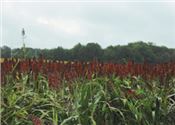|
Sorghum Acres Way Down As Insect Pest Takes Its Toll

Grain sorghum in Mississippi held at 5,000 acres for the second year in a row, a casualty
of a new pest that drives the cost of production to unprofitable levels.
Photo by MSU Extension Service/Bonnie Coblentz
STARKVILLE, MISS.
Grain sorghum has never been a major agricultural commodity in Mississippi, but it has seen better days: For two years in a row, acreage of the crop has been less than one-tenth of its annual average.
The annual average for grain sorghum is more than 56,000 acres, but Mississippi farmers planted about 5,000 acres in 2017 and 2018. Economics are partly to blame, but a new pest that started infesting the crop in 2013 is mostly responsible for this decline, which mirrors a national trend.
“Economic issues will help or hurt sorghum, but the main cultural issue we’ve had is that the sugarcane aphid adapted and began using sorghum as a host,” said Erick Larson, Mississippi State University Extension Service grain agronomist. “This is causing a lot of heartache and reduced the profit potential for that crop substantially in our area.”
Angus Catchot, Extension entomologist, said the ability of the pest to quickly increase numbers exponentially makes it hard to manage.
“Sorghum acreage declined because of the low price of grain sorghum combined with greater overall management costs, which also includes sugarcane aphid control,” Catchot said. “This pest requires intense and frequent scouting, but it can be successfully controlled with no impact on yield as long as it is detected early.”
Larson said sorghum historically has been a low-maintenance crop grown under tough conditions, and it filled an important niche in the state.
Sorghum prices are usually within 5-10 percent of corn prices. The crop produces reliably on poorer quality soil and more droughty conditions than corn. When sorghum prices were high a few years ago, sorghum acres rose.
“When that market incentive went away, growers abandoned grain sorghum primarily because the pest is still there,” Larson said. “If you can make 200 bushels per acre of corn but only 120 of sorghum, you can pretty quickly see there is more profitability with corn.”
Sorghum offsets the economic disadvantage by being a good choice for crop systems.
“Growing sorghum in rotation with corn or cotton helps disrupt a lot of pest cycles that get worse when you plant the same crop every year,” Larson said. “It also helps in the battle against glyphosate-resistant weeds. When you plant a different crop in rotation, you have different chemicals you can use that attack those weeds more efficiently.”
Crop rotation also boosts productivity. For example, if a grower plants cotton for several years in a row and then plants sorghum for one year, cotton yields in the following year would be about 15 percent higher than the last cotton crop.
Growers typically harvest sorghum in late August through September. The U.S. Department of Agriculture estimated 68 percent of the state’s sorghum was harvested by Sept. 23. Extended rainfall at harvest can cause sorghum heads to sprout and the quality to degrade.
Josh Maples, Extension agricultural economist, said Mississippi farmers planted 13,000 acres of grain sorghum in 2016. The state’s recent high was 115,000 acres harvested in 2007.
“Grain sorghum prices depend on location and are about the same as last year, with cash prices at approximately $3.10 per bushel,” Maples said. ∆
|
|